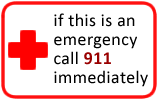Suture or Staple Questions
Suture or Staple Questions
Does this describe your symptoms? |
Click image for more info |
Definition
Suture Removal Date: Guidelines for when particular sutures (or staples) should be removed:
Numbness of Skin Near a Laceration
|
If not, see these topics
|
When to Call Your Doctor |
Call Your Doctor Now (night or day) If |
|
|
|
Call Your Doctor Within 24 Hours (between 9 am and 4 pm) If |
|
|
|
Call Your Doctor During Weekday Office Hours If |
|
|
|
Self Care at Home If |
|
|
HOME CARE ADVICE |
General Care Advice for the Sutured or Stapled Wound
Suture Care for a normal sutured wound:
Can get wound wet (e.g., bathing or swimming) after 24 hours.
Apply antibiotic ointment 3 times a day (Reason: to prevent infection and a thick scab).
Cleanse with warm water once daily or if it becomes soiled.
Change wound dressing when wet or soiled.
A dressing is no longer needed when edge of wound closed (usually 48 hours). EXCEPTION: dressing needed to prevent sutures from catching on clothing.
Removal Date: Guidelines for when particular sutures (stitches) or staples should be removed:
Face 4-5 days
Neck 7 days
Scalp 7-10 days
Chest or abdomen 7-10 days
Arms and back of hands 7-10 days
Legs and top of feet 10 days
Back 10 days
Palms and soles 12-14 days
Overlying a joint 12-14 days
Removal Delays: Do not miss your appointment for removing stitches. Stitches removed late can leave unnecessary skin marks and occasionally cause scarring. Delays also makes suture removal more difficult.
Suture Out Early: If the sutures come out early, reinforce the wound with tape or butterfly Band-Aids until the office visit
Wound Protection: After removal of sutures:
Protect the wound from injury during the following month.
Avoid sports that could re-injure the wound. If a sport is essential, apply tape before playing.
Allow the scab to fall off on its own. Do not try to remove it.
Pain Medicines:
For pain relief, take acetaminophen, ibuprofen, or naproxen.
Acetaminophen (e.g., Tylenol):
Take 650 mg by mouth every 4-6 hours. Each Regular Strength Tylenol pill has 325 mg of acetaminophen.
Another choice is to take 1,000 mg every 8 hours. Each Extra Strength Tylenol pill has 500 mg of acetaminophen.
The most you should take each day is 3,000 mg.
Ibuprofen (e.g., Motrin, Advil):
Take 400 mg by mouth every 6 hours.
Another choice is to take 600 mg by mouth every 8 hours.
Use the lowest amount that makes your pain feel better.
Naproxen (e.g., Aleve):
Take 250-500 mg by mouth every 12 hours.
Use the lowest amount that makes your pain feel better.
Extra Notes:
Acetaminophen is thought to be safer than ibuprofen or naproxen in people over 65 years old. Acetaminophen is in many OTC and prescription medicines. It might be in more than one medicine that you are taking. You need to be careful and not take an overdose. An acetaminophen overdose can hurt the liver.
Caution: Do not take acetaminophen if you have liver disease.
Caution: Do not take ibuprofen or naproxen if you have stomach problems, kidney disease, are pregnant, or have been told by your doctor to avoid this type of medicine. Do not take ibuprofen or naproxen for more than 7 days without consulting your doctor.
Before taking any medicine, read all the instructions on the package
Call Your Doctor If:
Looks infected
Fever
Sutures come out early
You become worse
Preventing Scars - Questions About
Preventing Scarring:
Be certain to get the sutures removed during the time frame that your doctor recommended (Reason: if you leave them in too long they can leave "railroad tracks").
Avoid getting a sunburn in this area for 2 months.
Avoid re-injuring this area.
Some people apply Vitamin E lotion (or cream) to a healing wound to prevent scarring. Research has not shown that this helps.
Scarring:
Scarring is unfortunately a natural part of the healing process after a cut or wound from surgery or trauma.
The more serious the injury and the larger the wound/cut, the greater the likelihood of scarring.
Almost all cuts that require closure with sutures, staples, or skin glue will heal with some scarring.
Some people are more prone to scarring than others.
And remember, contact your doctor if you develop any of the "Call Your Doctor" symptoms.
Updated:
March 22, 2017




